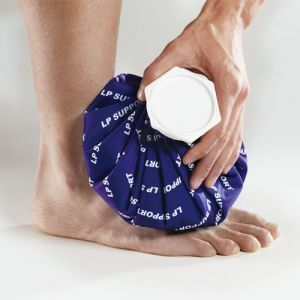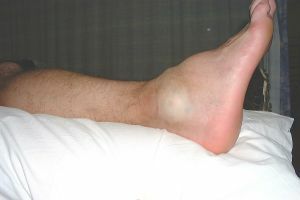 In everyday life, many had to face bruises.
In everyday life, many had to face bruises.
The most common injury is the bruise of the foot, which can be obtained with an unsuccessful fall on the foot, jump, impact.
Most of these troubles are due to inattention and carelessness. It is important to be able to provide timely medical assistance to such victims in order to avoid undesirable complications.
Contents of the article
- What happens when a bruise?
- Factors that cause injury
- Zoning of trauma on foot
- Signs of trauma: how to distinguish from fracture
- Diagnostic techniques
- First aid
- Treatment of injured area
- Complications can be avoided if. ..
- Rehabilitation measures
What happens when a bruise?
Contusion is a damage that is not accompanied by a breach of the integrity of the skin, as it often happens with a fracture of the foot.
However, minor blood and lymphatic vessels that lead to hemorrhage in the damaged area are injured. Depending on the severity of the injury, there is a bruise or even a large hematoma. Sealing is noticeable in the area of the injury. The function of the muscles, which are abnormally contracted, are disturbed.
Factors that provoke injury
Since the foot actively participates in the movement, and its functionality is very diverse, it is this part of the body that is most often injured.
The reasons for the injury may be as follows:
- hit the foot with a heavy blunt object;
- hit about any object;
- squeezing of the foot;
- the fall of a man from a height;
- falling on the leg of any object;
- unsuccessful jump.
Zoning injury on the foot
It is common to identify such major groups of the foot injury:
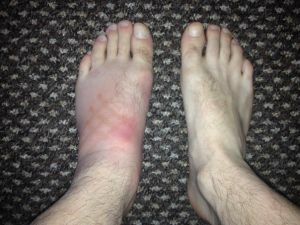
In the photo, the soft tissue injury of the foot
- The injury of the fingers is the most common injury in this area. It arises from the impact of a blunt object. Quite often you can get damage of this nature in the summer when people wear open shoes. Injury accompanies soft tissue damage. Characteristic signs: the appearance of swelling, discoloration in the area of trauma, sharp acute pain, limitation of motor function. Often there is damage to the nail plate. Diagnosing the bruise of the toes, it is important to exclude the rupture of the capsule and intra-articular fracture. The contusion of the soft tissues of the rear and the injury of the foot of the foot occurs as a result of the squeezing of the foot, the fall of a person from the height, the collision on the foot of vehicles, the falling heavy objects on the foot, etc. Characteristic signs: swelling, pain, discomfort of the motor function. Bruising can not be seen immediately, they appear only on the 2-3 day after the injury. Visually, they can be seen on the back surface, but on the sole they are observed rarely. At a time when strained hematomas are forming, there is numbness of the foot, a feeling of heaviness in the area of damage, restriction of movements - the so-called hypertensive ischemic syndrome.
Signs of trauma: how to distinguish from fracture
Immediate symptoms of a foot injury immediately appear:
- severe pain occurs immediately after an injury, with time it does not pass, but becomes less acute;
- appears swelling, which will be more pronounced after 10-15 minutes;
- in the area of damage, heat is felt;
- occurs a hemorrhage of varying severity;
- motor function is limited.
If timely not to take the necessary measures, then the hematoma will increase, thereby increasing the pain. As a rule, any bruise passes through 2-3 weeks of rehabilitation period.
Diagnostic Techniques
When getting an injury in the foot, it is important to make an accurate diagnosis. It can be done by a trauma doctor. If the foot is injured, treatment is required, as in any other trauma.
But before proceeding to any procedures, it is necessary to exclude other, heavier damages.
After a palpation, the doctor will determine if there is a fracture. With the help of an X-ray study, the nature of the trauma - a dislocation of the foot or a bruise - is diagnosed.
First aid
Treatment should begin with the provision of first aid. To reduce the likelihood of unwanted consequences, it is necessary to perform a number of simple actions:
- To ensure complete rest of the to the damaged foot, no load on it.
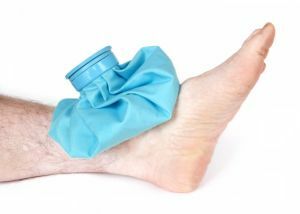
- Apply the restraint. It is ideal to use for this purpose elastic bandage, but the usual, or simple pieces of fabric, will do. Bandage is recommended tightly, but not tight, not to squeeze blood vessels.
- Apply cold compress with ice .Due to the fact that the cold causes a vasospasm, it will be possible to reduce pain and minimize the likelihood of developing edema or bruising in the area of the injury. Use cold is advisable only in the first day after getting injured. Apply repeatedly, every 20 minutes with five-minute breaks.
Treatment of injured area
In order to recover as quickly as possible, treatment of traumatic foot should be approached in a comprehensive manner. The usual damage to this plan is successfully treated at home.
Severe cases require the constant supervision of a physician .It should be noted that if there is a large hemorrhage in the cellular space of the foot, then it is possible to avoid surgical intervention.
Periodic use of this method promotes rapid resorption of the hematoma and the final disposal of pain.
Everyone can prepare a warm compress. To do this, it is sufficient to heat ordinary cooking salt in a frying pan and pour it into a tissue sack.
In addition to the proposed methods, you can use ointments, gels, creams containing painkillers and anti-inflammatory components.
 These agents help to remove swelling, promote resorption of the hematoma and eliminate pain. By means of such preparations as "Dimexide", "Heparin", "Lyoton", "Ibuprofen", etc.increases the effectiveness of treatment.
These agents help to remove swelling, promote resorption of the hematoma and eliminate pain. By means of such preparations as "Dimexide", "Heparin", "Lyoton", "Ibuprofen", etc.increases the effectiveness of treatment.
After 3-4 days, you can connect to the treatment complex a full-scale foot and finger massage, as well as gymnastics for restoring the motor activity of the joint.
As additional procedures, physiotherapy methods( electrophoresis, paraffin applications, magnetotherapy, etc.) are used, which can be added exclusively by the doctor after 7-10 days of treatment.
While the swelling and pain have not decreased, it is recommended to use while walking with a cane or crutch.
Complications can be avoided if. ..
Complications can develop if the treatment was untimely or wrong. In
, such situations are highly likely to develop hemarthrosis and synovitis, which is a cluster of inflammatory fluid or blood in the joint.
If the cartilage of the articular surface is damaged, posttraumatic arthrosis may occur. If the limb has been in the state of fixation for a long time, or if restoring gymnastics has not been carried out, trophic disturbances can occur.
Rehabilitation measures
Restoration of a damaged limb depends on a number of factors, namely:
- compliance with all prescription prescribed by the doctor;
- severity and degree of injury;
- individual characteristics of the body.
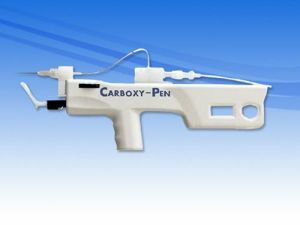
Carboxytherapy - an innovation in the treatment of injuries and joint diseases
As methods of rehabilitation after a foot injury, such methods as physiotherapy, massage, physiotherapy, manual therapy, occupational therapy, mechanotherapy have proven themselves.
Modern medicine can boast the introduction into practice of new and no less effective methods( carboxytherapy, electro acupuncture).
It is impossible to insure yourself completely from getting injuries and bruises. But to reduce the risk of an accident is quite possible for everyone.
To do this, it is enough to be more cautious and careful. If, however, a foot injury is received, all efforts should be directed to the provision of first aid, thus preventing the development of unwanted complications.


